Ba-Di-Yah! Say do you remember…Ba-Di-Yah! CicLAvia in September! The next one on September 15 – the 6th of 2024 and the 55th-ever is in the smaller CicLAmini format, but it’s a totally new route, in the Eastside neighborhood of Lincoln Heights. Running entirely along North Broadway between Avenue 18 and Lincoln Park Avenue, it runs through a corridor steeped in history. Located on the extreme northeast edge of the original 1850 Los Angeles City Limits, the neighborhood was one of the first established on the outer fringes of town. In 1863, John Strother Griffin (hence Griffin Avenue) purchased 2,000 acres of farm and sheep ranch land from the former Mexican land grant Rancho Rosa Castilla (more on this later) and started developing it in 1870 by building Victorian homes. Being east of the city, Griffin dubbed his development, “East Los Angeles.” Lincoln Heights is the O.G. East Los!
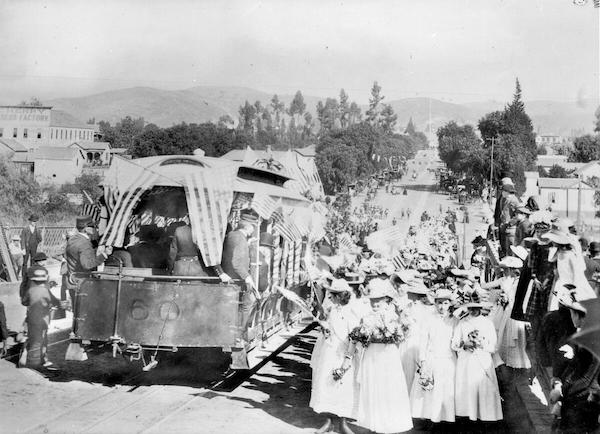
In 1888, the Los Angeles Cable Railway built a cable car line (just like the ones up in Frisco) connecting downtown Los Angeles and Lincoln Heights along Downey Avenue, the main corridor of the community. By the mid-1890s, the cable cars gave way to electric-powered streetcars and the Los Angeles Railway’s L Line replaced the old cable car. Commercial development flourished along Downey Avenue (one of the original TODs in the city!), with residential neighborhoods immediately behind it. In the late 1900s decade, new bridges were proposed across the Los Angeles River, causing the re-alignment and re-naming of streets. In 1908, the City made the old Downey Avenue a continuation of Broadway running through Downtown, a name that remains today. In 1917, the community decided to re-name themselves Lincoln Heights, referring to its hilly terrain near Lincoln Park (which itself was re-named from the former Eastlake Park after its proximity to Abraham Lincoln High School up the street). Today, the community is one of the neighborhoods that comprise Los Angeles’ Eastside (although many newer residents think otherwise…[side-eye]), which is located east of the Los Angeles River (and don’t you forget it!). The street car might be gone since 1940, but the buildings and institutions built to be in close proximity to it still shape how Lincoln Heights is defined today.
As usual — Happy CicLAvia, Go Dodgers, Go Rams and see you or not see you on the streets!
If you found this Epic CicLAvia Tour guide useful and visit any of these sites, please add the #EpicCicLAviaTour hashtag to any social media post that includes it. The Militant will be glad to re-tweet!
And if you appreciate The Militant’s work, kick him a little love via PayPal! He *hates* asking for money, but you know how it is these days…A Militant’s gotta pay his bills! He sacrifices a lot of his time to do this! Your support is much appreciated!
Support The Militant Angeleno!
https://www.paypal.com/donate/?hosted_button_id=K5XC5AM9G33K8
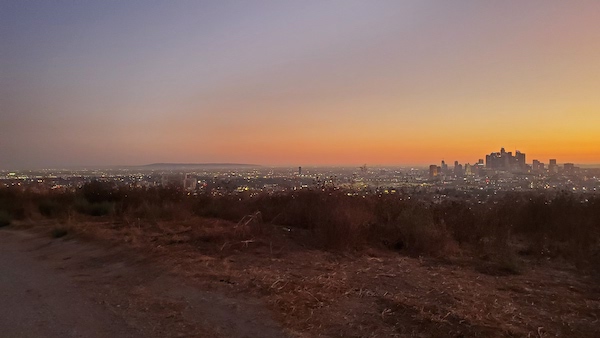
1. Paradise Hill/Rose Hills
Hillside area north of North Broadway, Lincoln Heights
Overlooking Lincoln Heights to the northeast stands a rounded promontory known as Paradise Hill, a 33-acre hillside area that has remained undeveloped since the Tongva people called this land their home. The hill, which has A-M-A-Z-I-N-G vistas of the Downtown Los Angeles skyline for those able to navigate Amethyst Street to get up here, contains an ecosystem of some 60 known wild animal species and is also home to one of the last remaining groves of Black Walnut trees in the Los Angeles area. Though presently golden, Paradise Hill lives up to its name in the Springtime with natural greenery and native Lupines and California Wild Roses growing here. There is a community-based movement to protect the land from proposed development and turn it into publicly-owned park space. The original Tongva village name for this area was Otsungna, which meant “Place of the wild roses,” a name that would linger on in the Spanish/Mexican rancho name Rancho Rosa Castilla and today’s Rose Hills (not to be confused with the other Rose Hills in Whittier). The hills themselves, made up of sedimentary and conglomerate rock, are part of the Repetto-Montebello Hills system, which stretches from the Arroyo Seco to the Rio Hondo. Remember that not-so little M4.4 shakey-quakey in El Sereno last month? That earthquake was centered only about a mile northeast of here along the Puente Hills Thrust Fault, responsible for creating these hills in the first place.

2. Holgate Square
1880
Holgate Square, south of North Broadway, Lincoln Heights
The transit-oriented strip of Downey Avenue, now known as North Broadway was one of the earliest examples of intentional Transit-Oriented Development in Los Angeles, which defined the outlay of the Lincoln Heights community, even decades after the last Los Angeles Railway Yellow Car rolled by. Developer William Holgate and his wife Mary bought this parcel and built their family home here on this balloon loop street off of North Broadway in 1880 and subdivided it in 1907, with eight additional single-family homes being built on the street between 1911 and 1925. A mortared cobblestone gateway along North Broadway forms the gateway to the neighborhood and the stone work motif continues in the yard walls of many of the houses here.
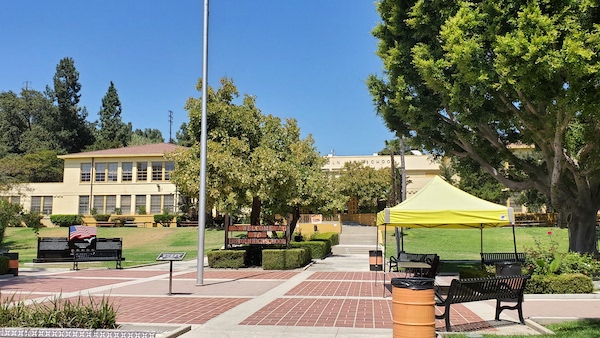
3. Lincoln High School
1878
3501 N. Broadway, Lincoln Heights
Founded in 1878 as Avenue 21 Grammar School near the opposite end of Sunday’s CicLAvia route (where the 5 Freeway runs today), the formerly-primary school moved its campus to its current location in 1913, became a high school and was re-named after the 16th president, as it was the 50th anniversary of the Emancipation Proclamation and the both the milestone and Lincoln were celebrated frequently in the media that year. In 1916, Lincoln High principal Ethel Percy Andrus became the first woman high school principal in California (later in life, in 1958, Andrus founded the American Association of Retired Persons (AARP) – which happens to be a major sponsor of CicLAvia). Lincoln High is unique among LAUSD schools for several reasons: It has a “split” campus configuration with the athletic field, gymnasium and additional classrooms being located across Lincoln Park Avenue (with the school’s landmark pedestrian bridge connecting the two parts). And while many schools are named after their respective communities, Lincoln High has the opposite – the community was named (indirectly) by the school. In 1917, the former Eastlake Park down the street was renamed Lincoln Park after the nearby secondary school, and soon after, the old community known as “East Los Angeles” became Lincoln Heights. In March 1968, the Chicano student activist movement was started by Lincoln High students. The campus is currently undergoing a $277 million modernization project slated to be completed in 2027. Famous alums include Rams running back Kenny Washington (the first African American player in the NFL), Dodgers 1981 World Champion pitcher Bobby Castillo and actress Jennifer Love Hewitt. Go Tigers!
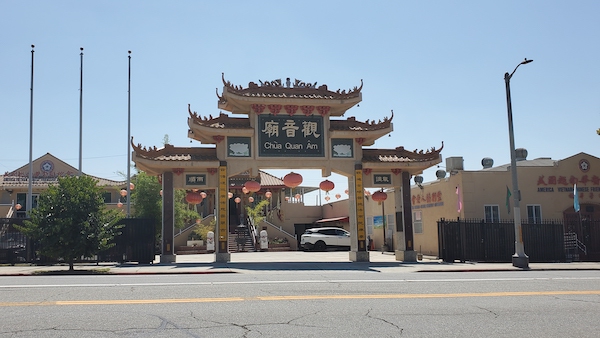
4. Kwan Ying Vietnamese Buddhist Temple
1993
3224 N. Broadway, Lincoln Heights
Though it may not be as well-known as Little Saigon in OC’s Westminster, or even the Chinatown area, Lincoln Heights is home to a significant Vietnamese American community. After Mexico, Vietnam is the country where the largest percentage (17%) of foreign-born Lincoln Heights residents hail from. This temple, conveniently located between Chinatown and the San Gabriel Valley, has been serving adherents since 1993. The Mahayana Buddhist temple is also host to Tet/Lunar New Year celebrations each year, as well as other community and family events. The adjoining and related America Vietnam Chinese Friendship Association located next door provides social services and linguistic/cultural classes to temple community members. BTW, the “Chùa Quan Âm” on the entrance arch is Vietnamese for “Temple Kwan Ying” – Kwan Ying (Guanyin in Chinese) being a Buddhist divinity commonly associated with compassion.

5. Horace P. Dibble House/HM157
1880
3110 N. Broadway, Lincoln Heights
This two story Queen Anne-style house shrouded behind a sextet of palm trees of was built in 1880 – Dude, that’s 144 years ago! It was the residence of one Horace P. Dibble, a salesman who worked for a local kitchenware company whose claim to fame was his involvement in a violent workplace dispute in June 1886 that had him charged with the knife attack murder of his co-worker, James Wallace. It made local headlines back in the day, and ultimately Dibble was acquitted in October of that year after the court ruled that he acted in self-defense. Dibble lived with his wife at this home for some 25 years. In 1976 the house was designated as Los Angeles Historic-Cultural Monument No. 157 and since 2007 it has been home to an artists’ colony known as HM157 (as in Historic Monument 157), which serves as a music venue, gallery, live/work space, farm, and location for public and private events, film/photo shoots, cinema screenings, eco-workshops and skill sharing and is considered the heart of Lincoln Heights’ arts scene.

6. Lincoln Heights Branch Library
1916
2530 Workman St., Lincoln Heights
The second-oldest operating branch library in the Los Angeles Public Library system (after the 1913 Vermont Square branch in South Los Angeles), this was the fifth of six branch library buildings funded and built by a $210,000 grant from steel magnate Andrew Carnegie in the 1910s, who was known for using his philanthropy to build over 3,000 libraries around the world. Opened in August 1916 as the North East Branch Library (when the community was still named “East Los Angeles”), the single-story semicircular building was designed by Lester H. Hibbard and H.B. Cody. With an Italian Renaissance/Colonial Revival design inspired by the Villa Papa Giulia near Rome, Italy, its facade contains elements stipulated by Carnegie, found in every Carnegie-built library: Lamps outside of the main entrance to symbolize enlightenment and stairways leading to the front entrance to symbolize the ascent of knowledge. In 1919, after the community was re-named Lincoln Heights, the branch library took on its current name. In 1983 it was designated as Los Angeles City Historic-Cultural Monument No. 261 and joined the National Register of Historic Places four years later. Of the six Carnegie-built LAPL branch libraries built in Los Angeles, only three remain – Vermont Square and Cahuenga in East Hollywood being the other two.
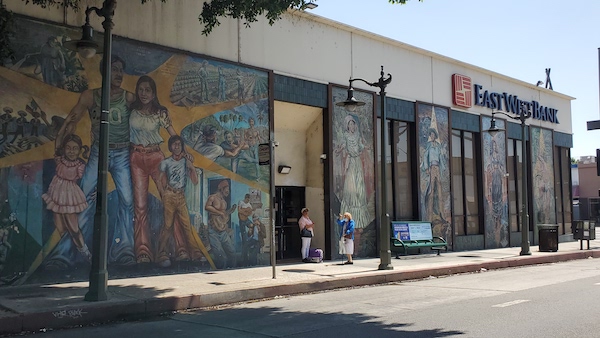
7. Chicano Time Trip Mural
1977
2601 N. Broadway, Lincoln Heights
One of the Eastside’s most iconic murals can be seen on the west-facing wall of the East West Bank building on North Broadway and Daly Street. Painted in 1977 by Eastside natives Wayne Healy and David Botello under the name “East Los Streetscapers” as a response to Mexican American heritage being ignored during U.S. Bicentennial events in 1976, the mural depicts a Chicano family of four surrounded by aspects of their history and heritage from the Aztec Empire to the late 20th Century. It was renovated by one of the original artists in 2006.

8. LADWP Lincoln Heights Customer Service Center
c. 1920s
2417 Daly St., Lincoln Heights
Located directly across the street from the Chicano Time Trip mural, this DWP facility, where one can pay their utility bills in-person and talk to a staff member regarding a water or power issue, functions the same today as it did when it opened in 1937. But note that it doesn’t look like any other government facility – it looks like…a movie theatre (Whaaa?) The DWP hired none other than celebrated architect S. Charles Lee (Los Angeles Theatre and Tower Theatre in Downtown, Bruin Theatre in Westwood, among many others) to design a Streamline Moderne makeover for their office, originally built around a century ago. But why does it say “Municipal Light Water Power” on the marquee-like facade? The signage reflected the transition period in the late 1930s when the City of Los Angeles’ Bureau of Power and Light was in the process of consolidating with the Bureau of Water Works and Supply before it was formally re-named the Department of Water and Power.

9. Federal Bank Building/El Pollo Loco
1910
2201 N. Broadway, Lincoln Heights
You already know that this white glazed marble Classical Revival building is too good-looking to be a chicken restaurant. Designed by architects Otto Neher & Chauncey Skilling (the latter of whom also designed Immanuel Presbyterian Church on Wilshire Boulevard), it originally opened in 1910 as a branch of Federal Bank, and was the first building in Los Angeles to have a triangular-shaped footprint. In 1986 the building was designated as Los Angeles Historic-Cultural Landmark No. 396, and in 1993 it underwent a $400,000 renovation to adaptively reuse it into an El Pollo Loco restaurant — the first fast food restaurant in Los Angeles to operate inside a historic landmark.
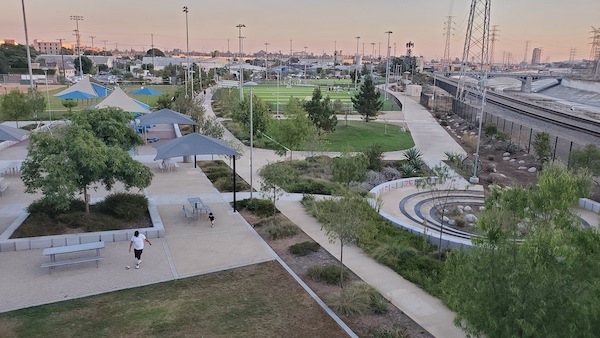
10. Downey Recreation Center/Albion Riverside Park
1961/2018
1772 N. Spring Street, Lincoln Heights
The triangle that sits between North Spring Street and North Broadway is Downey Recreation Center, a Los Angeles City park which features a swimming pool. But why the name “Downey” when the City of Downey is 10 miles southeast? John Gately Downey (1824-1894) was an Irishman who immigrated with his parents to the U.S. and served on the Los Angeles City Council in 1852. Later in his political career he was elected Lieutenant Governor of California and only five days after his inauguration in 1862 was sworn in as Governor of California due to the Governor being appointed to fill a vacant U.S. Senate seat. At the age of 32, Downey was the youngest person to serve as California governor. After politics, he returned to Los Angeles was one of the founders of the influential Farmers and Merchants Bank in 1871, and two years later founded the city that bears his name. Later that decade, he was one of the founders of the University of Southern California. He lived in what is now Downtown Los Angeles near Main and 3rd. Before 1908, North Broadway was known as Downey Avenue. Downey Recreation Center was built in 1961 and named after North Broadway’s legacy name (Many things were named after Downey, but the laundry fabric softener was not named after him). In 2019, the City opened a 6.3-acre extension of the rec center known as Albion Dairy River Park, located on the former site of the Ross Swiss Dairy on Albion Street along the east bank of the Los Angeles River.

11. North Broadway and North Spring Street Viaducts
1911/1927
North Broadway and North Spring streets over the Los Angeles River, Chinatown-Lincoln Heights
Between 1909 and 1940, the City of Los Angeles constructed 12 ornate bridges spanning the Los Angeles River from Hyperion Avenue in Atwater to 9th Street east of Downtown as part of the City Beautiful Movement of the early 20th Century. The untimely “concrete cancer” euthanization of the old 6th Street Viaduct (1932-2016) highlighted the design and significance of these spans, and two of them are right next to the end of the CicLAvia route. The North Broadway Bridge, originally known as the Buena Vista Bridge, was the first of these to be built, constructed between 1909 and 1911. At its opening, the 968-foot bridge was the longest and widest concrete span bridge in California. Designed by Homer Hamlin and Alfred P. Rosenheim, the Beaux Arts-style bridge features decorative Ionic columns on the entrances. On the west end of the bridge, look for Swallows’ nests built into the side of the structure, best seen while riding on northbound Metro (A) Line trains! In the 1920s, heavy traffic on the North Broadway Bridge led to the construction of it next-door neighbor, the Spring Street Viaduct, a Classical Moderne structure completed in 1927 and designed by John C. Shaw. In 2008, both bridges were designated as Los Angeles City Historic-Cultural Monuments (North Broadway, No. 907; North Spring, No. 900).
Happy CicLAvia on Sunday! Don’t forget to share this guide with a friend!

You must be logged in to post a comment.